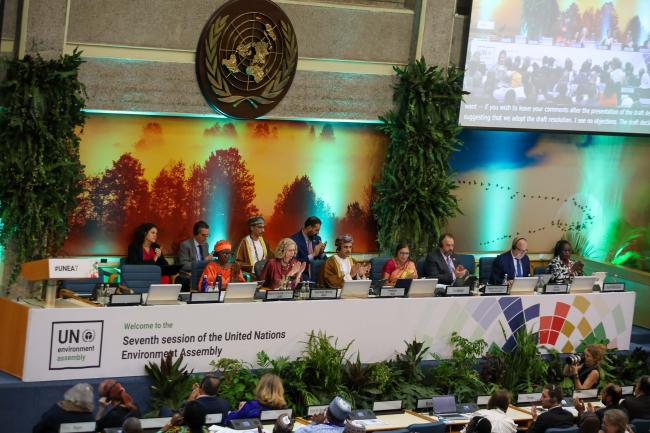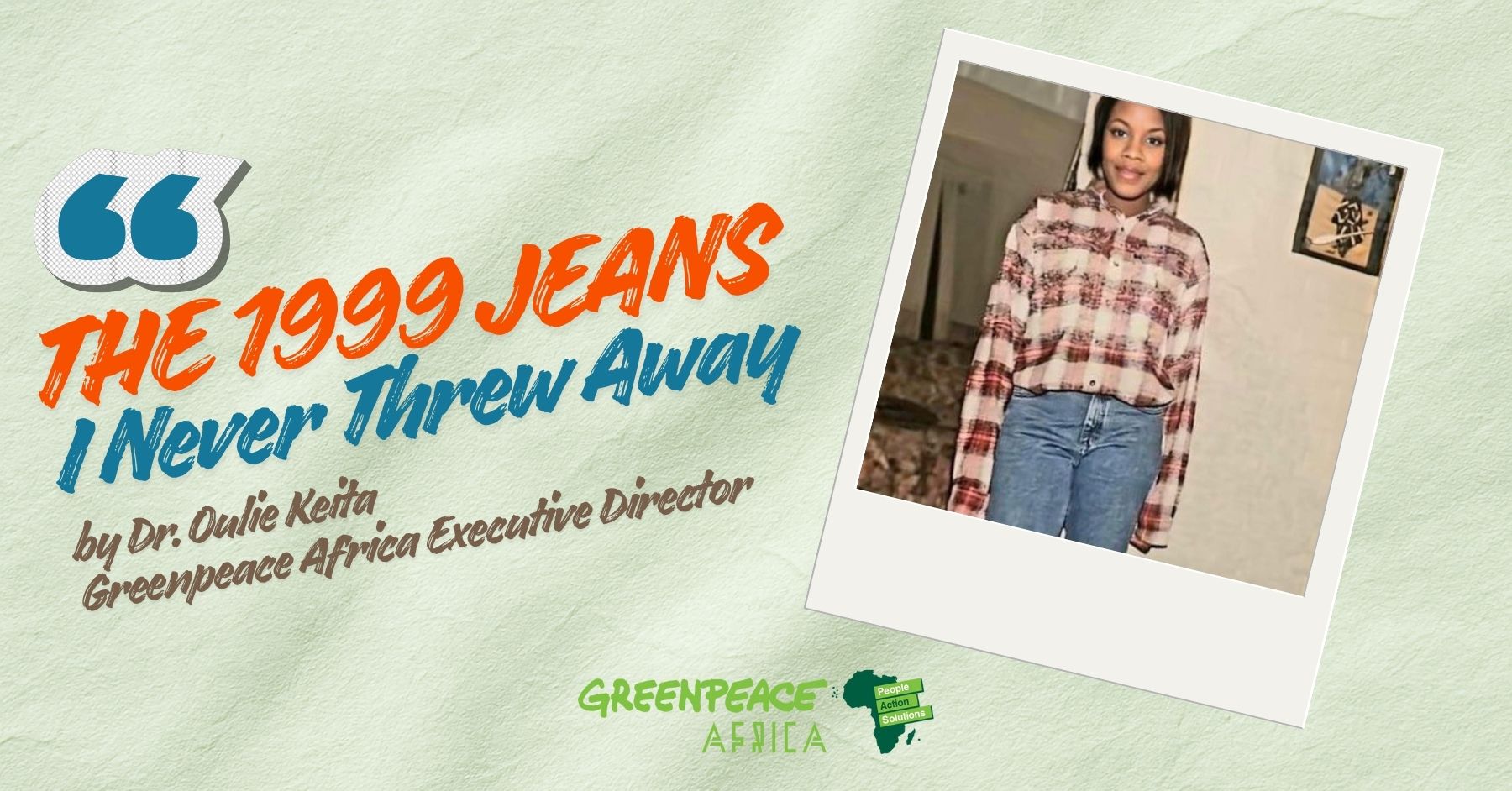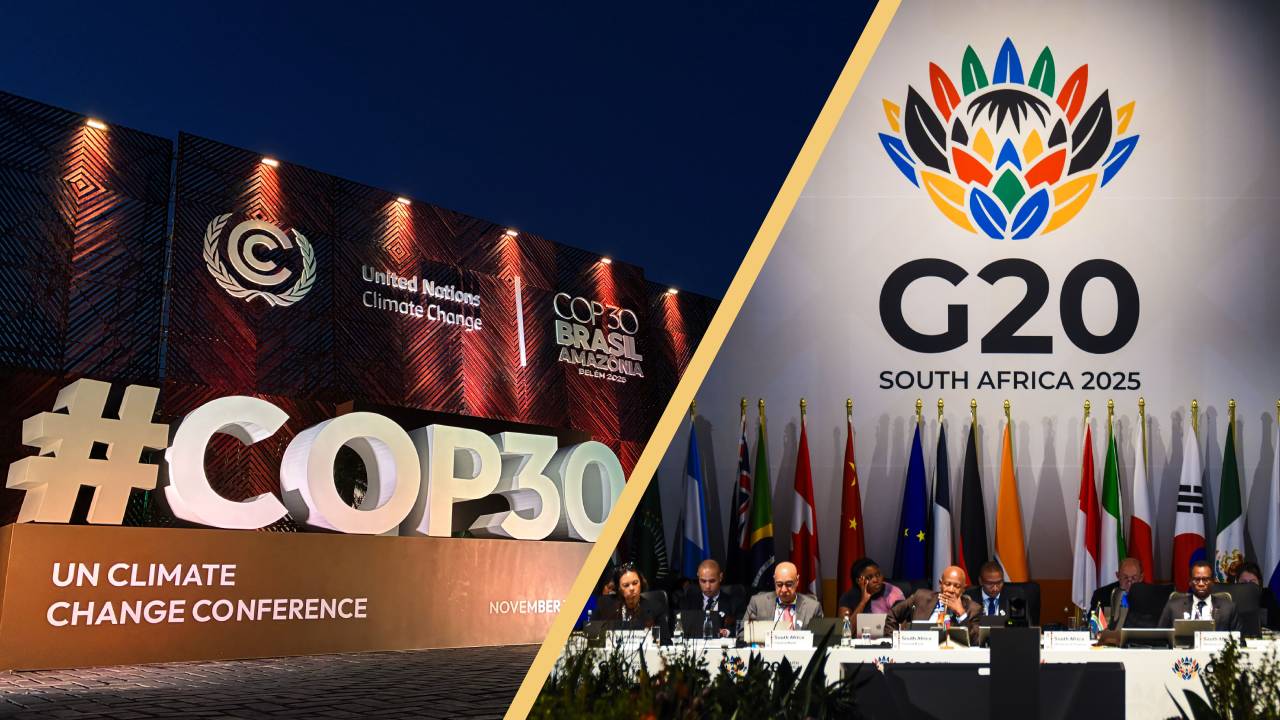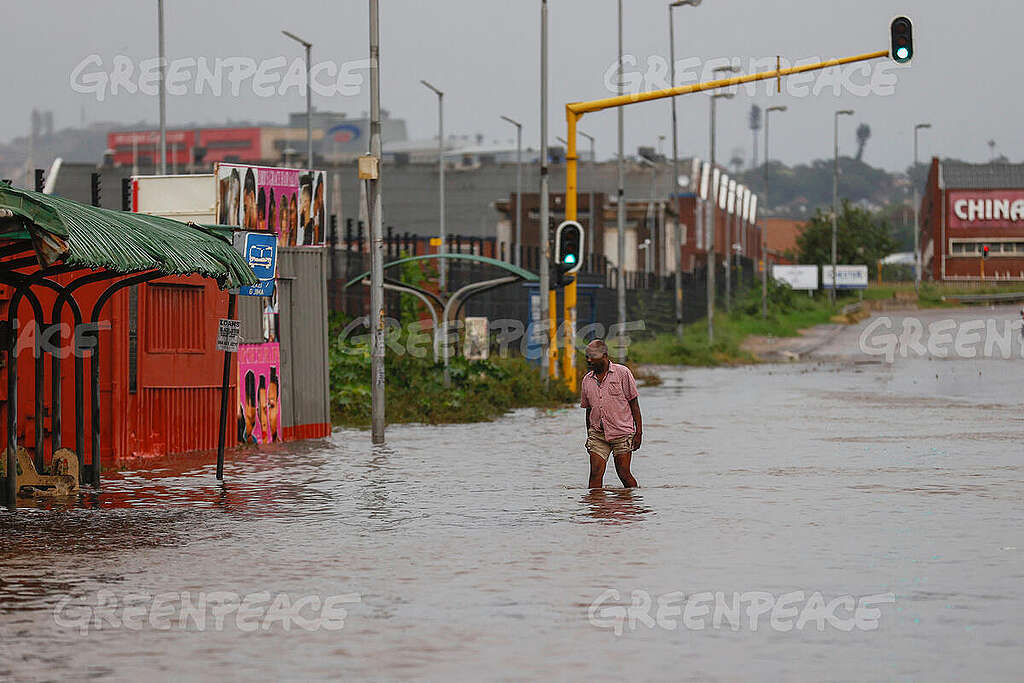
The Devastating Floods of South Africa & What You Can Do To Help
Deadly floods and landslides continue to devastate South Africa. Hundreds of thousands of people have been affected, thousands of homes have been destroyed and hundreds of people have tragically lost their lives.
The worst affected areas are in KwaZulu-Natal province, Durban, the country’s third largest city and a major port on the continent as well as the Eastern Cape provinces.
In addition to the floods, heavy rains are triggering disastrous mudslides that sweep away people, bridges, roads and entire buildings. The latest of these incidences happened just last month.
Floods in South Africa have been identified as one of the major climate disasters occurring in the country. Their occurrence and severity continue to increase due to global warming, climate change and the degradation of the environment by human activities.
It is becoming critical for us to be proactive in reducing these flood risks rather than reactive by providing post-disaster response and recovery.
South Africa is reeling from the effects of a changing climate. ADD YOUR VOICE to the thousands already appealing to African leaders to declare a climate emergency.
Floods in a Changing Climate
Climate change is a key concern in South Africa. South Africa’s per capita carbon emissions are higher than any other African country making South Africa particularly vulnerable to the effects of climate change.
The climate crisis is bringing with it changing rainfall patterns, increased temperatures, sea level rise and increased variability and severity of flooding incidents.
Flooding and the climate crisis are two threats to human well-being that reinforce each other.
Hence, they represent one of the greatest challenges to humankind in this century.
This is because while the adverse impacts of climate change on society may increase disaster risk, flooding catastrophes themselves erode environmental and social resilience and thus increase vulnerability to climate change.
Climate change – and the likely increase in flooding disasters – threatens to block pathways out of poverty. Any increase in flooding disasters, whether large or small, will threaten the ability of South African society’s most vulnerable to lead a dignified life.
Because of this, there is a growing need to address vulnerabilities to this climate emergency through mitigation efforts aimed at reducing the rate and magnitude of climate change and the flooding events that come with it.
“Extreme weather events are a direct consequence of bad energy policies, the senseless burning of fossil fuels and reckless destruction of our forests. The country must not wait for a miracle to avoid the next flood. Without breaking away from coal, protecting our rainforests and oceans, we will all end up queuing for Noah’s Ark,”
explains Amos Wemanya, Greenpeace Africa’s Campaigner.
The Effects Of Climate Change On Weather Patterns
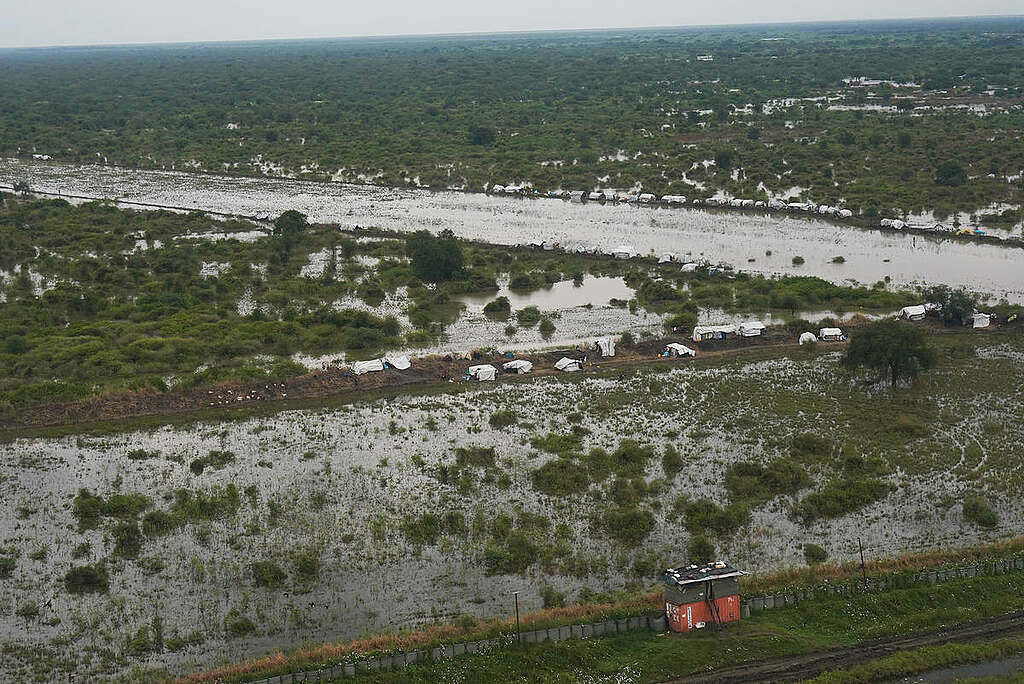
Climate change is making weather less predictable, rains more uncertain and heavy rainfall more likely. Currently, mean annual temperatures are increasing and extreme rainfall events happen more frequently now more than ever.
All these conditions culminate to create the perfect opportunity for flooding to occur.
(As of the last month, floods in the province of KwaZulu-Natal have left many Durban streets underwater and claimed hundreds of lives.)
These flooding hazards can only be mitigated if we as a society succeed in reducing greenhouse gas emissions. The temperature of the Earth has risen 1.1ºC above pre-industrial levels, leading to melting glaciers, rising sea levels, and various climate change impacts such as flooding, displacement of millions of people, and economic disparities.
The concentration of greenhouse gases has reached record highs, and real-time data shows that it is still increasing, resulting in further global warming. To limit global warming to 1.5°C above pre-industrial levels, emissions need to decrease by 43% by 2030, and we need to achieve net zero by 2050.
South Africa particularly needs to develop climate action plans to cut emissions and adapt to climate change impacts, but current commitments are insufficient to meet the Paris Agreement’s target of limiting warming to 1.5°C.
With such a huge crisis facing the entire planet, national response should be swift and decisive. Yet progress by the government has been achingly slow. Many commitments to reduce carbon emissions have been set, but few are binding and targets are often missed.
The South African Flood Problem
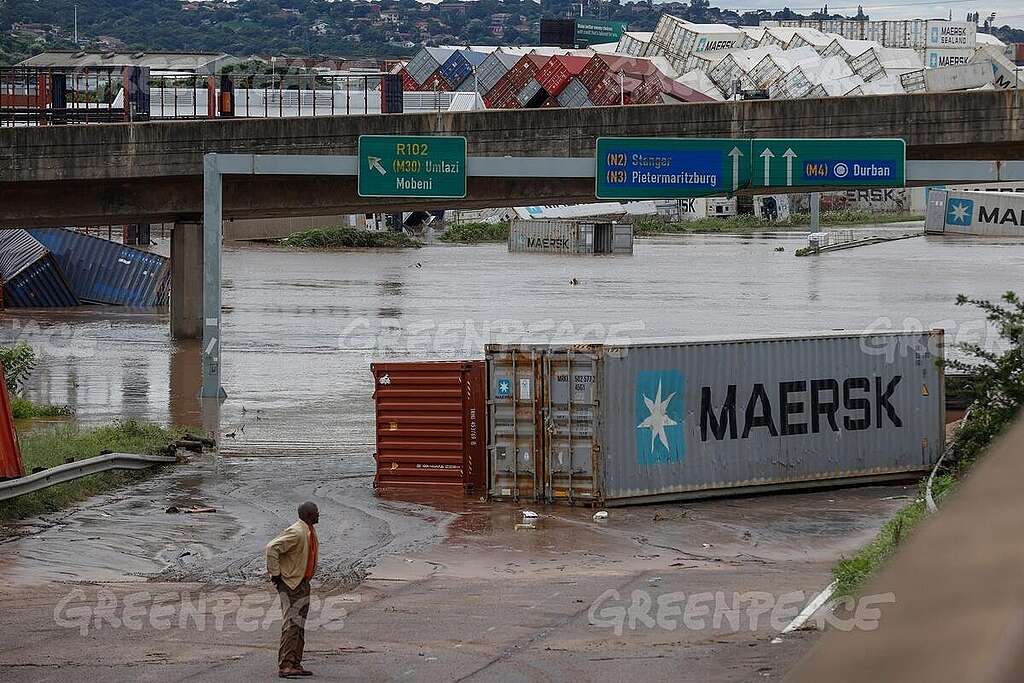
In recent years there has been a significant increase in floods around the country. Not only the frequency, but the severity of these flash floods have increased to such an extent that 100-year flooding events are becoming annual occurrences as months worth of rain falls in one day.
Floods in South Africa have been identified as one of the major climate disasters in the country due to the nation‘s semi-arid to arid climate.
In the Western Cape, flood tides are a common occurrence during winter. The provinces of South Africa are constantly experiencing more flooding incidents with each passing year.
Climate change has been proven to increase the occurrence of flooding due to fewer but more severe rainfall events.
To date, floods are the most frequently occurring climate disaster with the greatest loss of life. Fatality during a flood hazard event is largely due to drowning and severe injury. The long-term secondary effect is, however, more rigorous where affected communities are hampered by impacts such as disease and starvation.
Economic losses due to flood episodes are higher than any other hazard. Poor communities are more at risk due to the vulnerability of their livelihoods, especially in rural areas where access to services and infrastructure is limited.
Greenpeace Africa demands President Ramaphosa declare a climate emergency to unlock resources to implement contingency plans to mitigate further harm and enable South Africans to adapt to our quickly changing climate.
Types Of Floods Experienced In South Africa
First and foremost what is flooding? Flooding is the rising and overflowing of a body of water onto normally dry land. Floods can happen during heavy rains, when ocean waves come on shore, when snow melts quickly, or when dams or levees break. Damaging flooding may happen with only a few inches of water, or it may cover a house to the rooftop. Floods can occur within minutes or over a long period, and may last days, weeks, or longer. Floods are the most common and widespread of all weather-related disasters.
- Coastal or marine floods are caused by severe coastal storms with large waves that flood coastal areas and estuaries with seawater. The onset of coastal storms can usually be forecast between days to a few hours ahead.
- Riverine (fluvial) floods are caused by long periods of rain in the catchment area that increase the river’s water level and the overflow of river banks.
- Flash floods are the most dangerous kind of flood because they combine the destructive power of a flood with incredible speed. Flash floods occur when heavy rainfall exceeds the ability of the ground to absorb it, or when enough water accumulates for streams to overtop their banks, causing rapid rises of water in a short amount of time. They occur at hilly, upper reaches of river basins during intense rainstorms.
- Urban Flooding: Flash floods, coastal floods, and river floods can occur in urban areas, but the term “urban flooding” refers specifically to flooding that occurs when rainfall – not an overflowing body of water – overwhelms the local stormwater drainage capacity of a densely populated area. This happens when rainfall runoff is channelled from roads, parking lots, buildings, and other impervious surfaces to storm drains and sewers that cannot handle the volume.
Where And When Do Floods Occur in South Africa?
Flooding occurs in most South African provinces with Kwa Natal being most affected. Other provinces such as Mpumalanga and In Limpopo (north), a province bordering Zimbabwe frequently experience floods. However, all in all, floods in South Africa are a threat anywhere in the country as long as that region receives rain.
What Areas Are At Risk From Flash Floods in South Africa?
Densely populated areas are at high risk for flash floods. The construction of buildings, highways, driveways, and parking lots increases runoff by reducing the amount of rain absorbed by the ground. This runoff increases the flash flood potential.
Low spots, such as underpasses, underground parking garages, basements, and low water crossings can become death traps.
Areas near rivers are at risk from floods. Dam failures can send a sudden destructive surge of water downstream and lead to floods.
Causes of Flooding
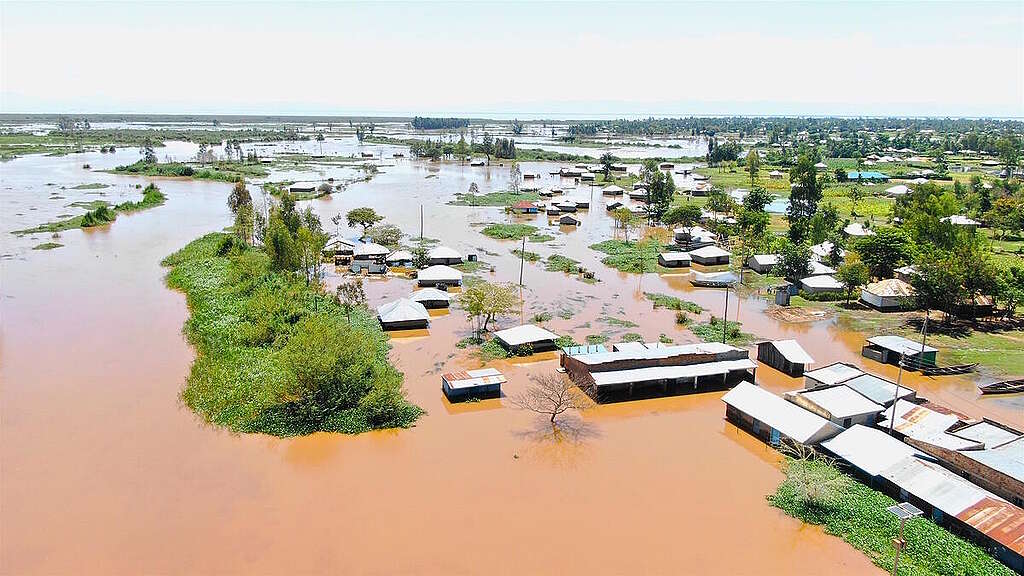
1. Warmer Ocean Temperatures Leading To Stronger Winds And Rains
First, the whole planet is getting warmer. Rising sea surface temperatures provide extra fuel for the development of tropical cyclones because they grow by heating from below.
Warmer seas mean potentially faster development of tropical cyclones, and stronger, more vigorous storms overall. As the oceans warm, these storms can reach farther from the equator.
Tropical cyclones (called cyclones in the Indian Ocean, typhoons in the Pacific Ocean, and hurricanes in the Atlantic Ocean) are storms that originate over the ocean when the surface water reaches or exceeds around 26 °C.
They have a closed low-pressure circulation with a pressure gradient that increases from the centre to the periphery of the system. This causes extremely strong winds, huge waves, and abnormally high tides along the coastlines.
These climate disasters primarily affected Madagascar, Mozambique, and Malawi and inflicted wide-scale damage with 230 reported deaths according to the World Weather Attribution (WWA).
Just recently, Cyclone Freddy brought about mudslides and floods, leaving nearly 200 dead in Malawi. The storm hit southern Malawi on 12 March 2023 bringing 300-400mm of rainfall in the first 48 hours alone. This brought sudden, violent and destructive flash floods and landslides. The cyclone set the record for the longest-lasting storm in the Southern Hemisphere as it lasted for over 35 days straight.
Tropical cyclones begin over the eastern Indian Ocean, east of Madagascar, and then move into a westerly direction. Their influence on South African rainfall is very limited as they do not occur often and when they do, they only last for a few days. Tropical cyclones usually occur in the summer months and influence the KwaZulu-Natal and Mpumalanga regions.
2. Destruction Of Vegetation Cover
The removal of the protective vegetation from the sides of mountains results in erosion of the topsoil which finds its way into watercourses and into the seas and oceans.
The resultant mudflows or landslides move at a rapid rate and are usually more destructive than flood water alone. Mudslides destroy crops, flood streets, engulf homes and destroy infrastructure along their path due to the velocity of the moving wall of mud and water.
3. The Senseless Burning Of Fossil Fuels That Is Exacerbating Global Warming
As the climate continues to warm due to continuing greenhouse gas emissions from the burning of fossil
fuels and other human activities, the world’s traditional weather patterns continue to change making climate disasters such as floods unpredictable.
As temperatures increase, they warm the atmosphere and warmer air can hold more water vapour. Every degree of warming increases the maximum amount of water vapour by around 7%. That extra water vapour tends to fall out as extra rain, this can lead to heavy rainfall events which increase the chances of flooding occurring.
Sea-level rise is another factor that can lead to coastal flooding. What’s causing the sea level to rise?
The sea-level changes are a direct consequence of rising temperatures as a result of fossil fuel burning which increases the amount of greenhouse gases in the atmosphere.
Global warming is causing global mean sea level to rise in two ways. First, glaciers and ice sheets worldwide are melting and adding water to the ocean. Second, the volume of the ocean is expanding as the water warms.
In a warming climate, the seas are expected to rise at faster rates, increasing the risk of flooding along our coasts.
4. Insufficient Drainage Management:
Improper planning of the drainage system of an area can cause excess water due to heavy rainfall to overwhelm a town or city’s drainage systems and lead to a flood, especially in cities and towns known for their high population.
As climate change accelerates and becomes deadlier, cities become more and more vulnerable. We need to move forward with early warning systems, coordinated response work, and of course, bold action to stop the climate emergency from getting worse.
5. Deforestation:
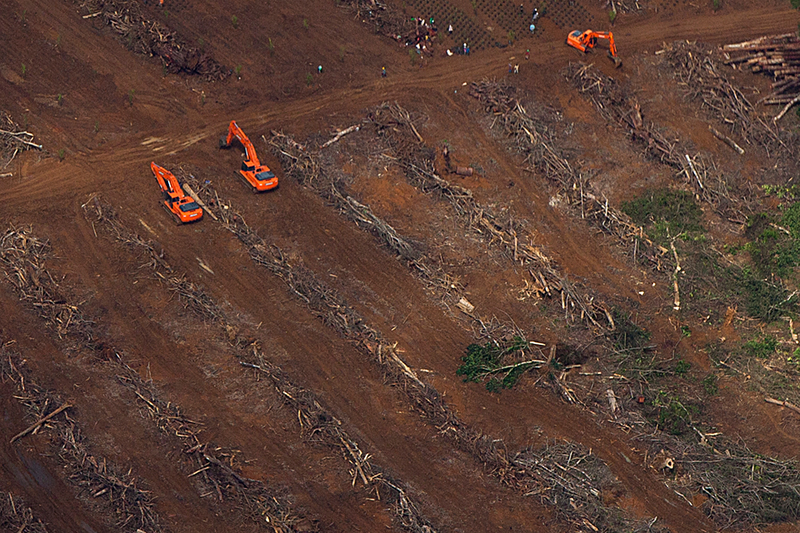
Deforestation is one of the major human causes of floods.
Forests and peatlands act as “carbon sinks” that accumulate and store greenhouse gases, majorly, carbon dioxide, the heat-trapping greenhouse gas that is the primary driver of recent global warming. The destruction of these ecosystems leads to the release of the carbon they were storing and as a result accelerates global warming.
Therefore, protecting and preserving forests is a critical strategy for mitigating global warming, addressing climate change, and the effects that come with it.
Another reason why deforestation accelerates flooding is because trees act like a sponge that helps to hold soil and water and prevent flooding.
The health of soil is also dependent on the existence of trees. When deforestation takes place, the top layer of soil can be dislodged – this is also known as soil erosion.
When the top layer of soil is unstable, it is unable to retain any of the water that falls on it, resulting in increased surface run-off, which, in turn, increases the risk of flooding. Deforestation also exacerbates the effect of flooding by increasing both the speed and amount of surface run-off as well as decreasing the amount of rainfall that is intercepted.
Deforestation can also alter the water cycle, leading to changes in precipitation patterns and the amount and timing of water flow in rivers and streams. These changes can increase the frequency and severity of flooding events in downstream areas, affecting communities, and causing significant economic and environmental damage.
6. Extreme Rainfall Events/Storms
Storms that form over land are potentially devastating if they coincide with areas of habitation or agriculture because of flooding and run-off. Extreme rainfall events are predicted to increase in frequency in the country with climate change.
In South Africa, extreme rainfall events can lead to floods due to a combination of factors such as:
- Soil saturation: When rainfall is heavy and prolonged, the soil becomes saturated and can no longer absorb water. This results in run-off, which can quickly accumulate and lead to flash floods. This is particularly true in urban areas where pavement and buildings prevent rainwater from being absorbed into the ground.
- River overflow: Rivers and streams can overflow their banks when heavy rainfall causes water levels to rise rapidly. This can be exacerbated by blocked waterways, such as when debris or plastic waste accumulates on bridges.
- Dam failure: Dams and reservoirs can become overwhelmed during heavy rainfall events, causing them to breach or fail altogether. This can result in massive amounts of water being released downstream, causing catastrophic flooding.
- Coastal flooding: Heavy rainfall can also cause coastal flooding in South Africa, particularly during storm surges. When high tides coincide with heavy rainfall and strong winds, the resulting storm surge can inundate low-lying coastal areas.
- Land use patterns: Human activities such as deforestation alter the landscape’s natural water balance, making it more prone to flooding. Deforestation, for instance, can reduce the soil’s ability to absorb water.
7. Poor Urban Drainage Basins
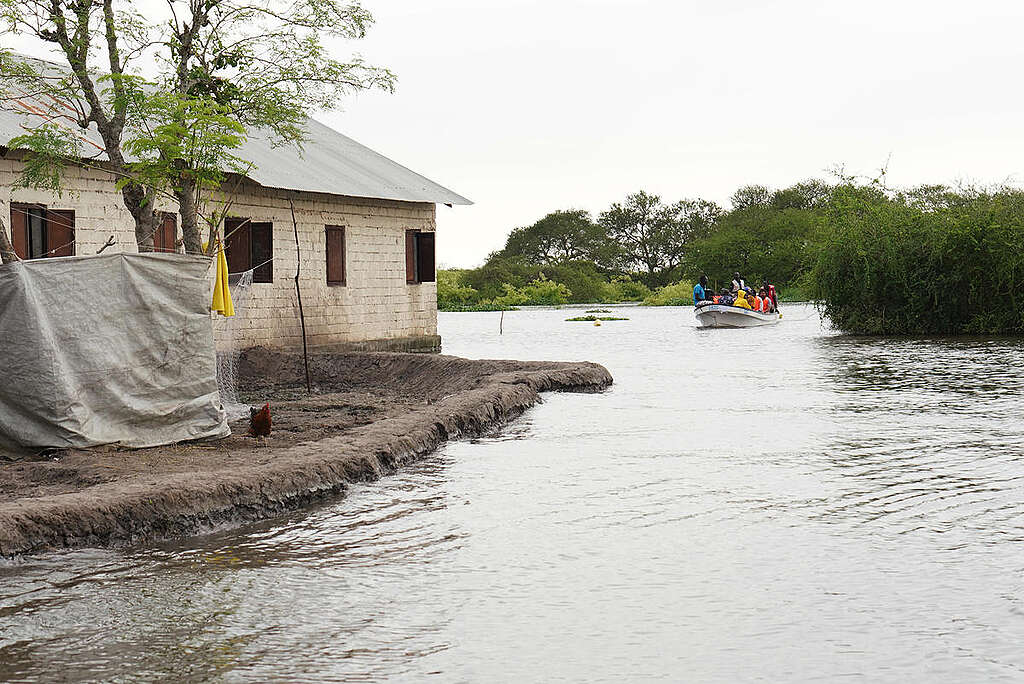
Many of our cities are made of mostly concrete and other impermeable material.
In urban areas, large amounts of impervious surfaces like roads, buildings, and sidewalks prevent water from being absorbed into the ground.
When you have an urban drainage basin that is made of concrete, there is no ground for water to sink into. So, when those drainage basins fill up, it means flooding for low-lying areas.
This is mostly the case in large urban areas — think Durban and Cape Town. When heavy rains strike, the basins used to drain them do not usually handle the load leading to floods in the cities.
The water that accumulates needs to run off these surfaces and needs to be carried away by a drainage system.
If the drainage system is inadequate or poorly maintained, the water can accumulate on the streets and cause flooding. Poorly designed drainage systems may also be overwhelmed during heavy rainfall events, leading to flooding.
Furthermore, urban areas often experience a high rate of development and construction, which can alter the natural flow of water and exacerbate flooding problems. For example, building on floodplains, filling in wetlands, or paving over green spaces can increase the amount of runoff and reduce the area available for water to be absorbed into the ground.
Therefore, it is crucial to ensure that urban areas have adequate and well-maintained drainage systems to prevent flooding. This may involve the construction of stormwater infrastructure or may also involve incorporating green infrastructure, such as rain gardens and green roofs, which can help absorb and manage rainwater.
How Has Climate Change Already Worsened South African Flooding?
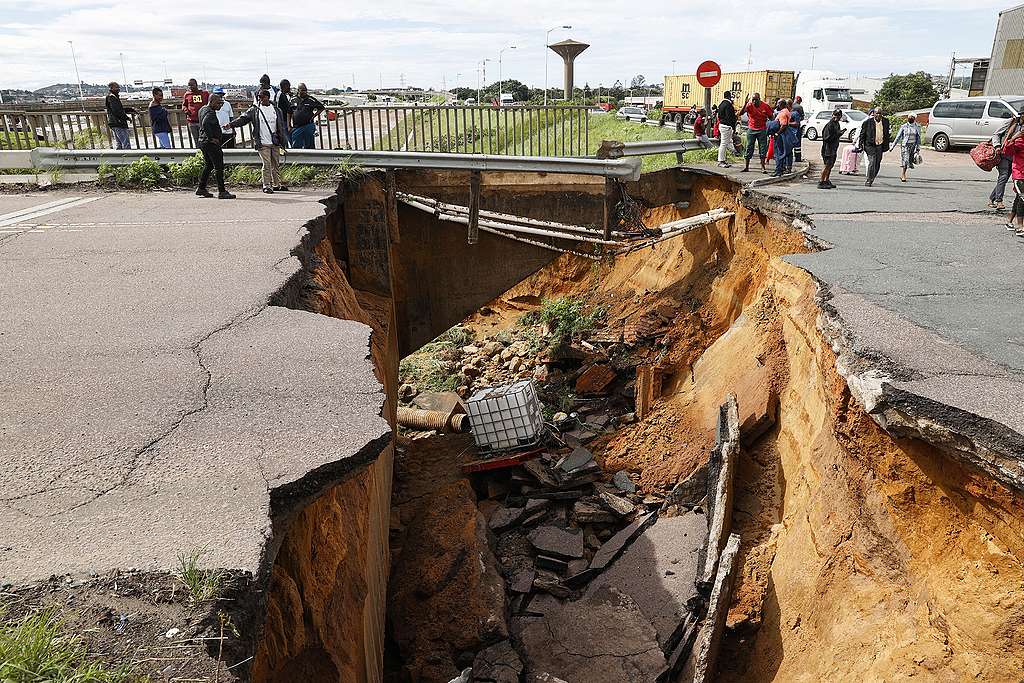
Exactly how does climate change lead to flooding?
1. Heavier Rains
Rising global temperatures means more rain.
Global heating causes more water to evaporate, which leads to an increase in the amount of annual rain.
At the same time, at higher temperatures, the air can hold more moisture content. This can lead to an increase in precipitation intensity, duration, and/or frequency.
Rather than gently watering plants, this intense rainfall leads to flooding disasters, like we’re seeing in South Africa now.
Climate change also has had a profound effect on the weather e.g severe tropical storms and cyclones. Combined, these factors fuel other extreme weather events like mudslides, flash floods or landslides.

A house is seen at night in a flooded neighbourhood of Bangui during a night patrol organised by the neighbourhood’s youth.
Part of the reason why we are experiencing extreme rainfall events is the result of more water vapor in the air, due to:
- Higher humidity: Rising atmospheric temperatures allow more water to be held in the gaseous state.
- Increased evaporation: Warmer temperatures facilitate surface evaporation in the water cycle. The greater volume of water vapor combined with heat and solar energy makes the storms increasingly severe, whether it’s in the form of summer rainstorms or winter blizzards.
Increased precipitation is not the only element to the story. More rainfall over shorter durations means that stormwater can’t drain off the surface or enter the ground fast enough to prevent flooding leading to pollution from stormwater runoff. Soil erosion is another issue, which causes soils to lose essential nutrients. Oversaturation of soils then leads to landslides.
2. Higher sea levels
Global warming is causing global mean sea level to rise in two ways. First, glaciers and ice sheets worldwide are melting and adding water to the ocean. Second, the volume of the ocean is expanding as the water warms. This can lead to coastal flooding in the absence of sufficient coastal protection. Increasing coastal flooding risks are threatening the achievement of a climate-resilient South Africa.
Primary And Secondary Impacts Of Flooding
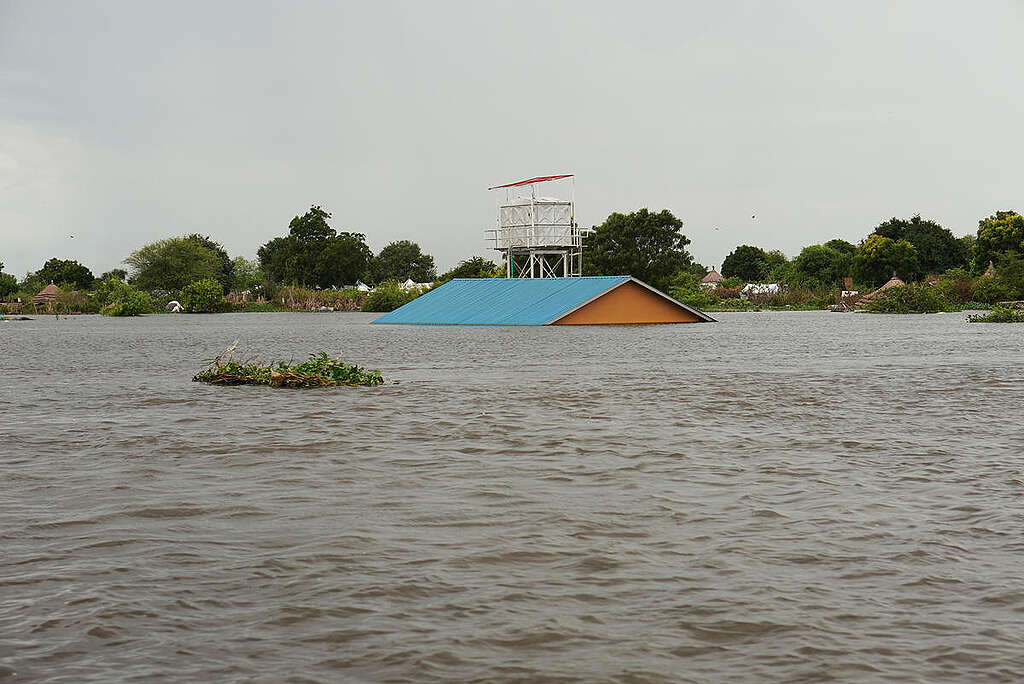
Floods have a negative influence on communities and their surrounding environment and can be severe and disruptive to their daily functioning.
The Following Are The Negative Effects That Arise Due To Flooding:
1. Damage to agricultural land and crops
Reduced crop productivity as a result of flood damage results in serious adverse effects on food security and on livelihoods at national and household levels here in South Africa.
2. Loss of human life
Flash floods are serious weather emergencies and are becoming more frequent with extreme weather events. Flash floods are majorly caused by excessive rainfall. Flash floods are dangerous and difficult to prepare for as they happen suddenly when there are heavy rains, sometimes within a few short hours making it very dangerous for individuals who live in areas prone to flash floods. The high velocity and debris load of flash floods and the difficulty in forecasting them make early warning and evacuation very difficult. They also make flash floods a high risk to human life as they claim a lot of lives in their wake.
3. Property and infrastructure damage
Damage to infrastructure also causes long-term impacts, such as disruptions to supplies of clean water, wastewater treatment, electricity, transport, communication, education and health care. Loss of livelihoods, reduction in purchasing power and loss of land value in the areas that are prone to flooding can leave communities economically vulnerable.
4. Damage to transport infrastructure
Damage to public infrastructure affects a far greater proportion of the population than those whose homes or businesses are directly inundated by the flood. In particular, flood damage to roads, rail networks and key transport hubs, such as shipping ports, can have significant impacts on regional and national economies.
5. Crop destruction and livestock loss
Flooding in key agricultural production areas can lead to widespread damage to crops and fencing and loss of livestock. Crop losses through rain damage, waterlogged soils, and delays in harvesting are further intensified by transport problems due to flooded roads and damaged infrastructure. The flow-on effects of reduced agricultural production can often impact well outside the production area as food prices increase due to shortages in supply.
6. Health risks due to water contamination
Floods are the leading cause of weather-related infectious disease outbreaks. Flooding events increase the chance of spreading waterborne diseases, such as cholera. Receding floodwater can create stagnant pools of water, which provide the perfect breeding ground for mosquitoes, which can transmit malaria and other diseases.
7. Housing displacement
Floods can also be devastating for communities living in affected areas. They damage homes and businesses as well as the very fabric of a community, forcing people to evacuate. As a result, many people are without a place to live for long periods and must rely on government assistance for food and shelter.
Additionally, some flood victims may never return to their homes or businesses due to the extent of the damage. This displacement will ultimately lead to climate migration, which may displace over 1.2 billion people by 2050 and lead to a global migrant crisis in the coming years.
8. Economic Impacts/Loss of livelihoods
As communication links and infrastructure such as power plants, roads and bridges are damaged and disrupted, economic activities come to a standstill, resulting in dislocation and the dysfunction of normal life for a period much beyond the duration of the flooding.
Event Spotlight: Climate Change & Recent Flood Disasters In South Africa
In 2022,
- In April 2022, Durban floods affected the South African province of KwaZulu-Natal. A total of 306 lives were claimed by this tragedy.
- Heavy rain and flash flooding in Gauteng Province, South Africa. Flooding struck areas of Ivory Park close to the Kaalspruit river in Tembisa (also Thembisa) northeast of Johannesburg late on 18 February 2022.
- In Gauteng Province heavy rainfall overnight, 04 to 05 February 2022, caused flooding in several parts of Tshwane and Ekurhuleni municipalities, including Mamelodi, Centurion, and Olifantsfontein.
- In KwaZulu-Nata flooding began in Ladysmith and Msinga after heavy rain from around 15 January 2022 caused the uThukela and Klip rivers to overflow. Dozens of homes, commercial buildings, roads, and bridges have been damaged.
- Heavy rainfall on 08 January 2022 triggered floods which affected areas of Mthatha, Buffalo City Metropolitan Municipality, the township of Mdantsane, and areas of East London.
In 2023,
- In Eastern Cape, severe flooding struck the town of Coffee Bay and surrounding areas of King Sabata Dalindyebo local municipality on 18 February 2023. Homes, schools and infrastructure were damaged. Six people were swept away by floodwater.
- Flooding struck in the town of Komani from 18 to 19 February, where more than 100 people were rescued.
- Flooding was reported in the city of Ladysmith in the KwaZulu-Natal province after the Klipriver broke its banks on 17 February. Several roads were closed, and homes and commercial buildings were flooded. No injuries or fatalities were reported.
All these flooding incidents show that we live in a world that cannot continue to adopt a business-as-usual approach to climate change. There is overwhelming evidence of our earth’s climate changing. As it changes it is having devastating effects on human life as evidenced by the massive death toll we have observed year in, year out here in South Africa.
What We’re Doing To Help
We are holding the government and Eskom accountable for their role in the extreme weather events happening in South Africa: It’s crucial to ensure that corporate interests are answerable for their actions. We recognize that the present approach of favouring corporate gains at the expense of our environment and the people of South Africa is obsolete and not viable. The time for coal is passed. The government needs to recognize the urgency of the Just Transition plan. We need to move to a more sustainable economy in a way that’s fair to everyone – including people working in polluting industries. Renewable energy and not dirty fossil fuel is how we curb climate change and its effects such as flooding.
We are fighting to protect forests and natural ecosystems that act like carbon sinks. We know that mother earth has the capacity to protect herself from the effects of climate change but only if she is protected. We are prioritising natural solutions such as reforestation, the protection of peatlands and forests that cut emissions directly and support the mitigation of floods and worsening climate disasters.
For many of us, climate change is a fight for life itself. That is why we are constantly taking to the streets with the help of activists from this same community. They are often on the front lines, facing down deforestation or kicking out fossil fuel industries that want to put their water supplies at risk from oil spills.
We’ve been let down by Governments who have failed to eliminate fossil fuels fast enough, and failed to redesign our towns and cities to be resilient enough to flooding. The government has simply failed to act. These floods bring home a stark truth: People and communities are paying the price of a climate crisis that’s driven by corporate greed and governments unwilling to stand up to them. It is up to us to demand change.
Taking Climate Action
There is a growing need to address South Africa’s vulnerabilities to climate change. Yearly floods are becoming a marker of South African life. Climate disasters such as floods wreck lives and livelihoods, and highlight the strong and urgent need for better climate adaptation and mitigation plans to reduce the occurrence of climate disasters in our country.
There is still time to act so future generations can enjoy the planet and all its givings to its people.
Our nation is particularly vulnerable to climate disasters such as flooding and landslides, these cannot be solved by citizens themselves, it requires a deliberate effort from the government. We can all come together to demand action from the South African government so that they can take the necessary steps to bring dignity to those affected by these flooding disasters.
Your support helps us continue fighting for the Earth. Make a difference by donating to us today.

